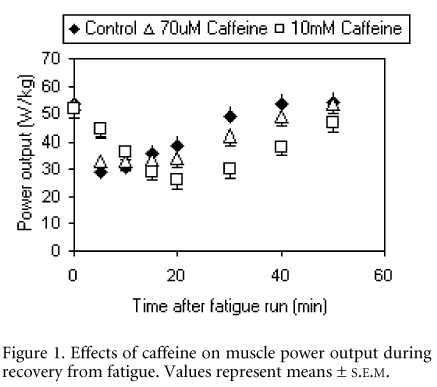Caffeine has previously been shown to cause rapid recovery of isometric muscle force generation following fatigue (Westerblad & Allen, 1991), eliciting speculation that caffeine supplementation may directly increase in vivo force in athletes (Graham, 2001). However, these in vitro studies used higher concentrations (mM) of caffeine than the micromolar concentrations found in human athletes during dynamic muscular actions. In this study, we examined the effect of both 10 mM (high) and 70 mM (physiologically relevant) caffeine concentrations on power production of mouse extensor digitorum longus (EDL) muscle during recovery from fatigue. Female CD1 8- to 10-week-old mice were killed by cervical dislocation and the EDL muscle was isolated in oxygenated Krebs-Henseleit solution (Barclay, 1996) at 35°C. Muscle stimulation was optimised to produce maximum power output at a work loop cycle frequency of 5 Hz using a total strain of 10 % of the muscle’s resting length (James et al. 1995). The muscle was then subjected to a fatigue run consisting of 50 work loop cycles. Immediately after the fatigue run, the bathing solution was replaced with either standard Krebs, Krebs containing 10 mM caffeine or Krebs containing 70 mM caffeine (n = 8 muscles for each treatment). Recovery from fatigue was monitored by regularly subjecting the muscle to a set of four control work loop cycles. After 10 min the bathing solution was replaced with standard Krebs solution to allow recovery to be further monitored during a wash-out period. The effect of caffeine treatment (5 and 10 min after fatigue) was analysed using ANOVA (with a Bonferroni post-hoc test). Power output was significantly higher in 10 mM treated EDL 5 min after the fatigue run (Fig. 1; P = 0.035). In contrast, 70 mM caffeine had no significant effect on EDL power output (Fig. 1).
The depressant effect of fatigue on force in EDL was partially reversed by exposure to 10 mM caffeine. However, 70 mM caffeine did not influence EDL force, suggesting that the concentrations of caffeine found in human athletes are unlikely to directly affect skeletal muscle.
This work was supported by a Royal Society Research Grant. R.S.W. was supported by GOA-BOF project (UIA99-03).
All procedures accord with current UK legislation.

